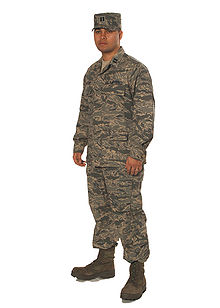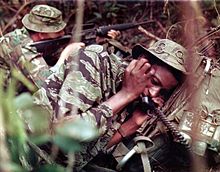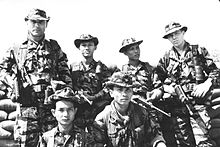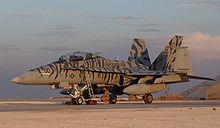- Tigerstripe
-
For other uses, see Tiger stripes.
Tigerstripe is the name of a group of camouflage patterns developed for close-range use in dense jungle during jungle warfare by the South Vietnamese Armed Forces/US Forces. It derives its name from its resemblance to a tiger's stripes. It features narrow stripes that look like brush-strokes of green and brown, and broader brush-strokes of black printed over a lighter shade of olive or khaki. The brush-strokes interlock rather than overlap, as in French Lizard pattern (TAP47) from which it apparently derives. There are many variations: R.D. Johnson counted at least 19 different versions in early drafts of Tiger Patterns, his definitive work on the subject, although it is unclear if these are all different print patterns, or if they include color variations of a few different print patterns.
Contents
History
It is unclear who developed the first tigerstripe pattern, consisting of sixty-four (64) stripes. The French used a similar pattern in their war in Vietnam [1], while simultaneously, the British used a similar pattern in Burma [2](Possibly the-then SAS Smock/Denison Smock). After the French left Vietnam, the Republic of Vietnam Marine Corps continued using the pattern, a variant of which was later adopted by Vietnamese Rangers (Biệt Động Quân) and Special Forces (Lực Lượng Đặc Biệt). When the United States began sending advisors to South Vietnam, USMAAG advisors attached to the ARVN were authorized to wear their Vietnamese unit's combat uniform with US insignia. Soon, many American special operations forces in the Vietnamese theater of operations wore the pattern, despite not always being attached to ARVN units: it became the visible trademark of Green Berets, LRRPs, SEALs and other elite forces.
Tigerstripe was never an official US-issue item. Personnel permitted to wear it at first had their camo fatigues custom-made by local tailors, ARVN uniforms being too small for most Americans; for this reason there were many variations of the basic tigerstripe pattern. From 1969 5th Special Forces Group contracted with Vietnamese producers to make fatigues and other items such as boonie hats using ARVN fabric. During the latter stages of the war, tigerstripe was gradually replaced by the-then-new ERDL[3] pattern, a predecessor of the woodland BDU pattern.
Besides American and ARVN forces, Australian and New Zealand military forces also used tigerstripe camouflage combat uniforms while on advisory duty in Vietnam, with Australian and New Zealand advisors to the ARVN, and Australian and New Zealand Special Air Service soldiers being the principal wearers of tigerstripe uniforms, while regular Australian and New Zealand ground forces continued wearing the standard-issue olive drab green combat uniforms.
Users
 Afghanistan - Afghan National Army, Afghan National Police.
Afghanistan - Afghan National Army, Afghan National Police. Argentina - Special Operations Group (Reddish Sparse pattern)
Argentina - Special Operations Group (Reddish Sparse pattern) Australia - Australian Special Air Service
Australia - Australian Special Air Service Dominican Republic - Dominican Air Force Guards, Police Special Service Unit.
Dominican Republic - Dominican Air Force Guards, Police Special Service Unit. Ecuador - Use a 'Flames' pattern.
Ecuador - Use a 'Flames' pattern. France - French foreign legion in French Guiana
France - French foreign legion in French Guiana Lebanon
Lebanon New Zealand - New Zealand Special Air Service
New Zealand - New Zealand Special Air Service Nicaragua - National Guard (Nicaragua) EEBI 'commando' troops in 1968-1979.
Nicaragua - National Guard (Nicaragua) EEBI 'commando' troops in 1968-1979. Paraguay -
Paraguay - Peru -
Peru - Philippines
Philippines Russia - OMON, Spetsnaz, VDV use Tigerstripe.
Russia - OMON, Spetsnaz, VDV use Tigerstripe. Singapore - Desert Tigerstripe pattern
Singapore - Desert Tigerstripe pattern South Korea
South Korea South Vietnam - ARVN Rangers and Marines
South Vietnam - ARVN Rangers and Marines Vietnam - Border war with China in 1979
Vietnam - Border war with China in 1979 Taiwan - Republic of China Marine Corps
Taiwan - Republic of China Marine Corps Thailand -
Thailand - United Kingdom - Special Air Service
United Kingdom - Special Air Service United States - United States Air Force
United States - United States Air Force
Current use
 U.S. Air Force ABU uniform, which presents modern version of tiger stripe camouflage.
U.S. Air Force ABU uniform, which presents modern version of tiger stripe camouflage.
The Tamil Tigers used a tiger stripe camouflage pattern in their uniforms, but it is graphically very different from the family of patterns famous as Tigerstripes from the Vietnam War. The Tamil Tigers' pattern lacks black, and is small and overwhelmingly horizontal.
Tiger Stripe Products, a professional camouflage designer, licenses variations to manufacturers for military use and for the civilian market. With input from Tiger Stripe Products, the United States Air Force developed a digital tigerstripe like pattern using various greens, greys, and blues for use with its new Airman Battle Uniform.
Digital MARPAT pattern used by U.S. Marine Corps was also influenced by tigerstripe. Of the two patterns shown here both are from the Vietnam era, the first one being a Tiger Stripe Products version of an early to mid Vietnam War pattern referred to as "John Wayne Dense" from its appearance in The Green Berets. The other version pictured is a product from the latter part of the war which is darker than most other patterns of Vietnamese War tigerstripe.
US Special Operations Forces such as the US Navy SEALs and the Green Berets are still using tigerstripe camouflage in operations in Afghanistan, and it has proved itself to be very effective for this type of environment.
Special fabric rather than pattern artwork design determines NIR detection. Near Infrared (NIR) Signature Management Technology is used by the U.S. Department of Defense to prevent detection by NIR Image Converters. These photocathode devices do not detect temperatures, but rather infrared radiation variances. NIR-compliant uniforms use a special fabric that allows soldiers to appear at the same radiation level as the surrounding terrain, thus making them more difficult to detect. NIR technology also make uniforms less visible in low-light environments by reducing the reflection of light.
See also
References
External links
- Tiger Stripe Boonie Article RallyPointMiliaria.com 2009
- Influence of tigerstripe on U.S. Marines MARPAT uniform
- Airman Battle Uniform based on tigerstripe
- Development of modern tigerstripe by U.S. Air Force
Further reading
Johnson, Richard Denis (1999). Tiger Patterns: A Guide to the Vietnam War's Tigerstripe Combat Fatigue Patterns and Uniforms. Schiffer Pub Ltd. ISBN 9780764307560.
Categories:- Military uniforms
- Camouflage patterns
Wikimedia Foundation. 2010.



